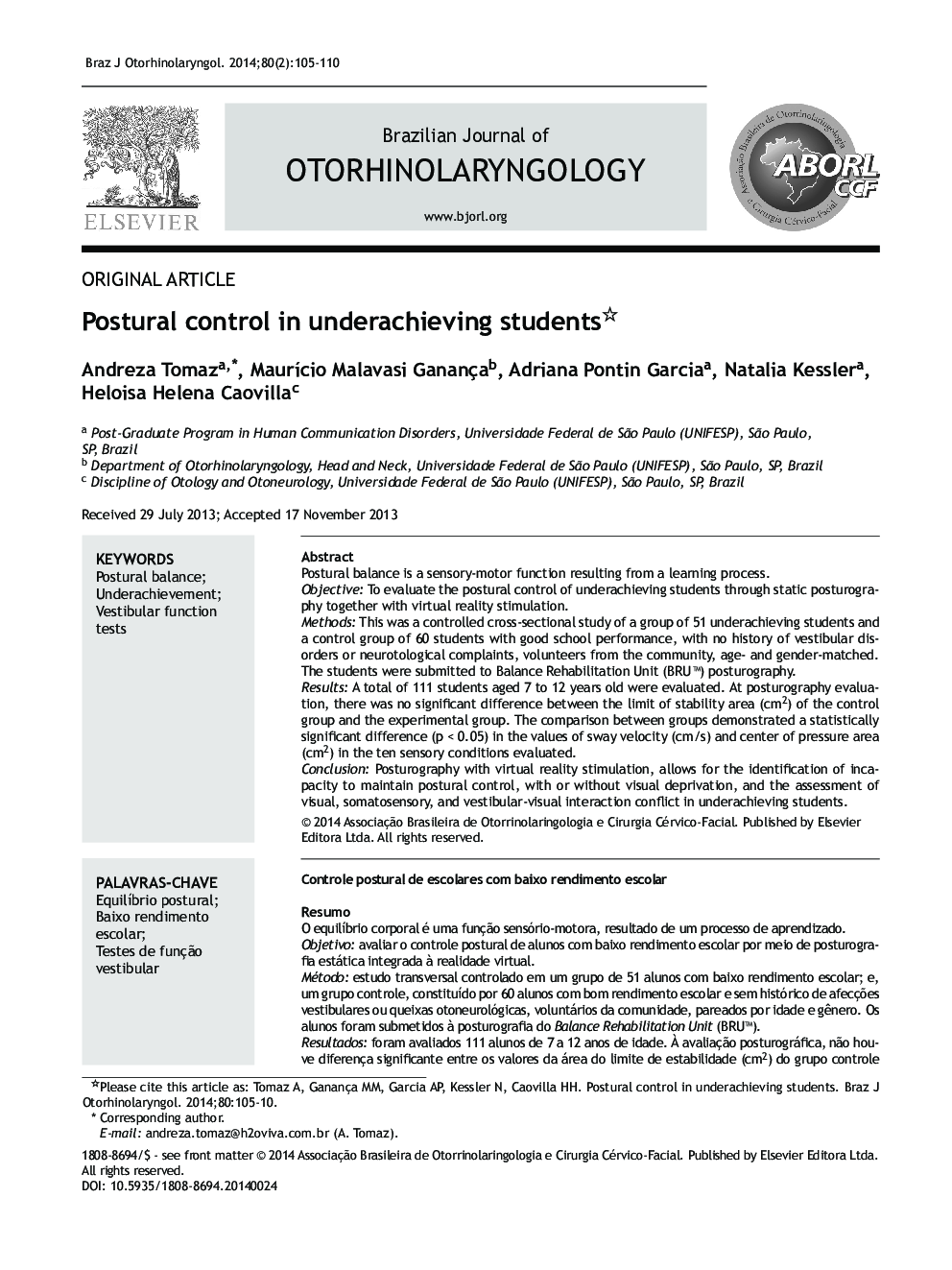| Article ID | Journal | Published Year | Pages | File Type |
|---|---|---|---|---|
| 4106447 | Brazilian Journal of Otorhinolaryngology | 2014 | 6 Pages |
Postural balance is a sensory-motor function resulting from a learning process.ObjectiveTo evaluate the postural control of underachieving students through static posturography together with virtual reality stimulation.MethodsThis was a controlled cross-sectional study of a group of 51 underachieving students and a control group of 60 students with good school performance, with no history of vestibular disorders or neurotological complaints, volunteers from the community, age- and gender-matched. The students were submitted to Balance Rehabilitation Unit (BRU™) posturography.ResultsA total of 111 students aged 7 to 12 years old were evaluated. At posturography evaluation, there was no significant difference between the limit of stability area (cm2) of the control group and the experimental group. The comparison between groups demonstrated a statistically significant difference (p < 0.05) in the values of sway velocity (cm/s) and center of pressure area (cm2) in the ten sensory conditions evaluated.ConclusionPosturography with virtual reality stimulation, allows for the identification of incapacity to maintain postural control, with or without visual deprivation, and the assessment of visual, somatosensory, and vestibular-visual interaction conflict in underachieving students.© 2014 Associação Brasileira de Otorrinolaringologia e Cirurgia Cérvico-Facial. Published by Elsevier Editora Ltda. All rights reserved.
ResumoO equilíbrio corporal é uma função sensório-motora, resultado de um processo de aprendizado.Objetivoavaliar o controle postural de alunos com baixo rendimento escolar por meio de posturografia estática integrada à realidade virtual.Métodoestudo transversal controlado em um grupo de 51 alunos com baixo rendimento escolar; e, um grupo controle, constituído por 60 alunos com bom rendimento escolar e sem histórico de afecções vestibulares ou queixas otoneurológicas, voluntários da comunidade, pareados por idade e gênero. Os alunos foram submetidos à posturografia do Balance Rehabilitation Unit (BRU™).Resultadosforam avaliados 111 alunos de 7 a 12 anos de idade. À avaliação posturográfica, não houve diferença significante entre os valores da área do limite de estabilidade (cm2) do grupo controle e os valores do grupo experimental. A comparação entre os grupos mostrou diferença significante (p < 0,05) nos valores da velocidade de oscilação (cm/s) e nos valores da área de deslocamento do centro de pressão (cm2) nas dez condições sensoriais avaliadas.ConclusãoA posturografia integrada à realidade virtual possibilita a identificação de achados de inabilidade para manter o controle postural, com e sem privação da visão, sob conflito visual, somatossensorial e de interação vestíbulo-visual, em alunos com baixo rendimento escolar.© 2014 Associação Brasileira de Otorrinolaringologia e Cirurgia Cérvico-Facial. Publicado por Elsevier Editora Ltda. Todos os direitos reservados.
